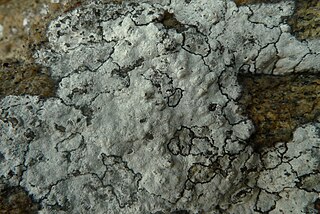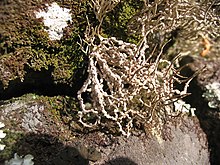
The Roccellaceae are a family of mostly lichen-forming fungi in the order Arthoniales, circumscribed by the French botanist François Fulgis Chevallier in 1826. Species in the family exhibit various growth forms, including crustose and fruticose thalli, and diverse reproductive structures. Roccellaceae species typically have apotheciate or lirellate ascomata, often with distinct blackened margins. Molecular phylogenetics studies have revealed significant genetic diversity and complex evolutionary histories within the family.

Roccellographaceae is a family of lichen-forming fungi in the order Arthoniales. It contains three genera: Dimidiographa, Fulvophyton, and Roccellographa.
Dictyographa is a genus of lichen-forming fungi in the family Opegraphaceae. It comprises three species of corticolous (bark-dwelling), crustose lichens. The genus was originally described by the Swiss scientist Johannes Müller Argoviensis in 1893, who distinguished it from related genera by its unique spore structure and interconnected filaments within its reproductive organs. Dictyographa lichens are characterised by their elongated, slit-like fruiting bodies and spores that are divided by both vertical and horizontal internal walls. The genus has been subject to taxonomic debate, with some researchers proposing to merge it with the related genus Opegrapha. However, genetic studies have since confirmed Dictyographa as a distinct evolutionary lineage. These lichens are found in various parts of the world, including Africa, the Middle East, and Hawaii, typically growing in coastal environments.
Baidera is a single-species fungal genus in the family Roccellaceae. It contains the species Baidera mauritiana, a corticolous (bark-dwelling), crustose lichen found in Mauritius. Both the genus and species were described as new to science in 2020 by Paul Diederich and Damien Ernst. The genus name honours Cláudia Baider, curator of the Mauritius Herbarium.
Diromma is a monotypic fungal genus in the family Roccellaceae. It contains the single species Diromma dirinellum, a rare crustose lichen that grows as a parasite on the lichen Dirina ceratoniae. It has a distribution restricted to the Mediterranean Basin.
Dirina catalinariae is a species of saxicolous (rock-dwelling), crustose lichen in the family Roccellaceae. It occurs in the southwestern United States, Mexico, and the Galápagos Islands.
Vigneronia spieri is a species of corticolous (bark-dwelling), crustose lichen in the family Roccellaceae. It is found in the Galápagos Islands, mainland Ecuador and the Antilles (Curaçao).
Dimidiographa is a genus of lichen-forming fungi in the family Roccellographaceae. It has three species of crustose lichens, with Dimidiographa loandensis serving as the type species.

Fulvophyton is a genus of lichen-forming fungi in the family Roccellographaceae. It has 11 species. Fulvophyton is characterised by its crust-like thallus, which is often pale yellowish-brown in colour. This genus features a photobiont from the green algal genus Trentepohlia and exhibits a unique arrangement of reproductive structures.
Aspiciliopsis is a genus of lichen-forming fungi in the family Trapeliaceae. It has two species, both of which occur in the Southern Hemisphere.
Placomaronea fuegiana is a species of saxicolous (rock-dwelling), crustose lichen in the family Candelariaceae. Found in South America, it was formally described as a new species in 2009 by Martin Westberg and Patrik Frödén. The type specimen was collected by the second author in Tierra del Fuego, Argentina, where it was found growing on sandstone. The species epithet fuegiana refers to the type locality. It also occurs in Pali-Aike National Park, where it grows in the pits of volcanic rocks.

Roccella albida is a species of saxicolous (rock-dwelling), fruticose lichen in the family Roccellaceae. It is found on the Galápagos Islands. The lichen is characterised by its distinctively shaped, cylindrical or slightly depressed branches that vary in length from 5 to 20 cm and are white to white-greyish in colour, with infrequent soredia. The lichen has a cottony medulla, commonly white or sometimes pale yellowish-brown, and has frequent ascomata with wavy margins.
Placolecis kunmingensis is a species of saxicolous (rock-dwelling), crustose lichen in the family Catillariaceae. It is found in Yunnan, China. The lichen is characterised by a thallus that is areolate to squamulose in its centre, forming irregular patches or clumps 10–50 mm wide, as well as its ellipsoid or spherical ascospores with slightly thickened wall.

Roccella gracilis is a species of fruticose lichen in the family Roccellaceae. Flourishing in coastal environments, Roccella gracilia predominantly grows along the coasts of Baja California and the Galápagos Islands, preferring the trunks, branches, and twigs of trees, but it is also found on rocks and cliffs. Its distribution spans coastal habitats from California south to Peru, including the Galápagos Islands and parts of the Caribbean.

Roccella galapagoensis is a species of fruticose lichen in the family Roccellaceae. It is endemic to the Galápagos Islands.
Arthonia darbishirei is a species of lichenicolous (lichen-dwelling) fungus in the family Arthoniaceae. Found on the Galápagos Islands, it was described as new to science in 2003 by Gerhard Follman and Birgit Werner. It was first collected on San Salvador Island in June 1872 during the Hassler Expedition. The fungus grows specifically on the thallus of Roccella nigerrima, a fruticose lichen that is endemic to the Galápagos. The species epithet darbishirei honours the British lichenologist Otto Vernon Darbishire (1870–1934), who initially described the host lichen and made significant contributions to the study of roccellaceous lichens.
Lecanographa imitans is a rare species of lichenicolous (lichen-dwelling) fungus in the family Arthoniaceae. Found on the Galápagos Islands, it was described as new to science in 2003 by Birgit Werner and Gerhard Follman. The holotype specimen was collected on Baltra Island, north of Santa Cruz Island, in January 1929. The fungus grows specifically on the thallus of Roccella gracilis, a fruticose lichen. The species epithet imitans refers to the potential confusion of its ascomata with the true fructifications of its host lichen.
Sparria is a small genus of lichen-forming fungi in the family Opegraphaceae.
Protoroccella is a fungal genus in the family Roccellaceae. It consists of the single species Protoroccella minima, a rare fruticose lichen found in Chile that grows on cactus.
Paraschismatomma is a fungal genus in the family Opegraphaceae. It comprises a single species, Paraschismatomma ochroleucum, a crustose lichen found along the western coast of North America from northern California to Baja California. The lichen grows as a thin, greenish-white crust on dead twigs, branches, and tree bark near the ocean. First described by the lichenologist Alexander Zahlbruckner in 1900, P. ochroleucum has undergone several name changes before being classified in its own genus in 2011.






